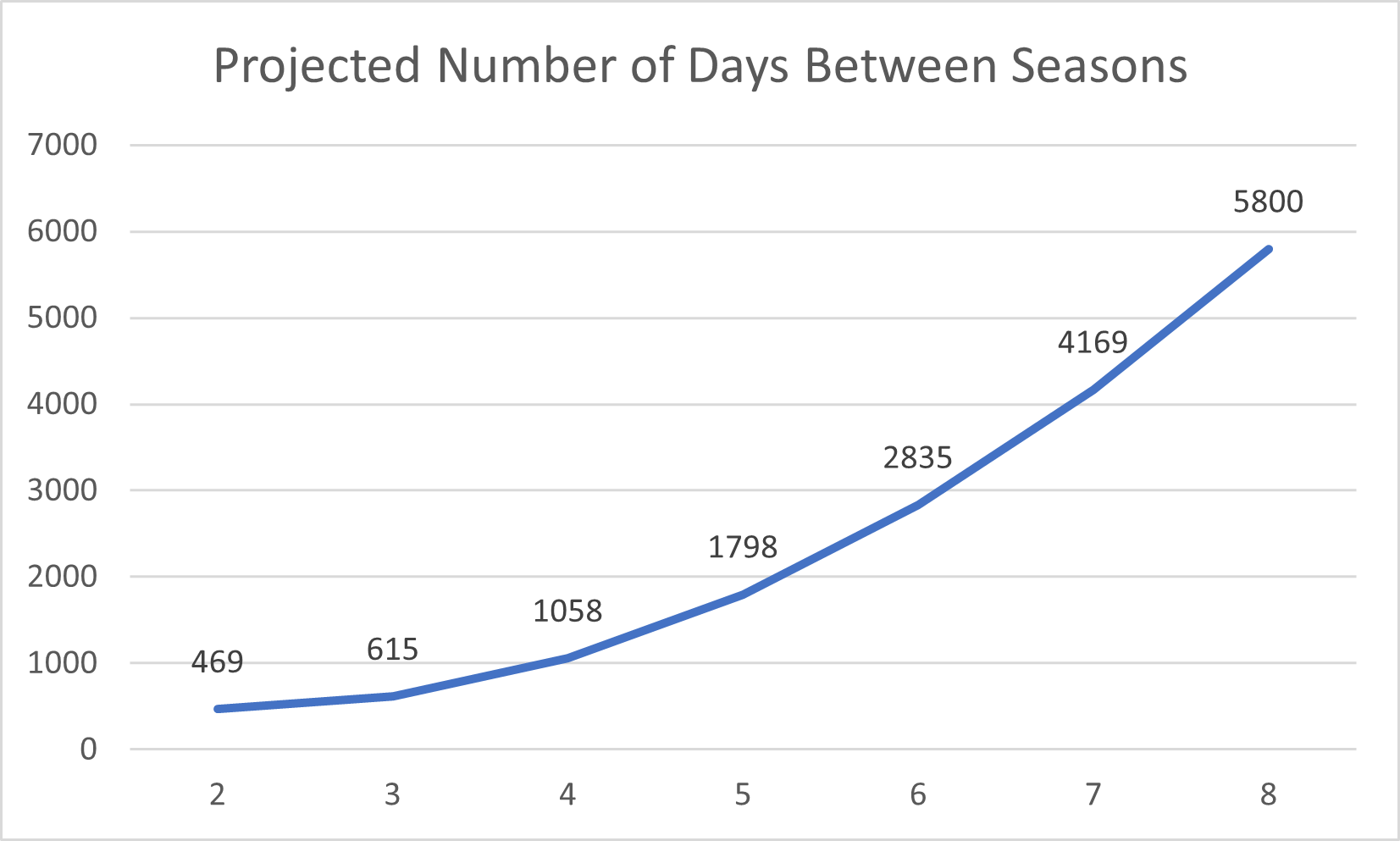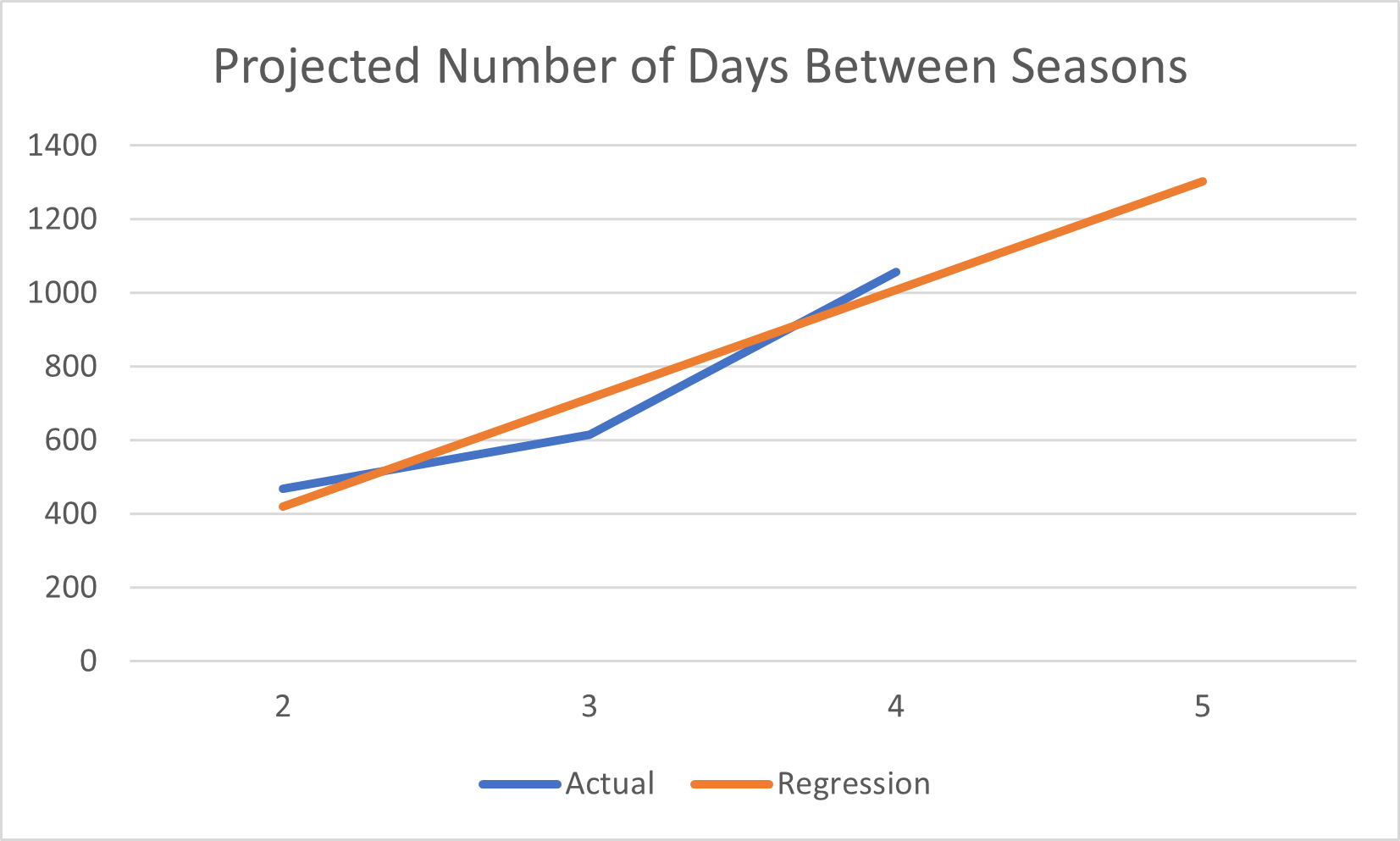Imagining Things
When Will Season 5 of Stranger Things be Released? (Satirical)
November 19, 2022 by Klugmeister
For fans of Stranger Things, the lengthening time between seasons is an area of concern. How long will we have to wait before Season 5 will be released? Inquiring minds want to know.
Well...we could extrapolate from the pattern of the first four seasons and see what that gives us. That doesn't mean we should do that—but, no one told us to visit Alaska either, and that turned out to be fun. Before we do that, however, we should point out up front that we have no inside information about the Duffer Brothers' plans, so readers looking for well-informed expectations of when Season 5 will be released should stop reading now.
Still here? Great!
Approach 1: Fit the Data to a Polynomial
One potential way to project the Season 5 release date would be to fit a polynomial through the data for the first four seasons, then plug Season 5 into that polynomial and see what pops out. Admittedly, this requires algebra, and may not produce an answer that passes a "smell test" for reasonability. But it sounds fun and adventurous, and it gives us something to do while we wait for the Duffer Brothers to get off their duffs. Also, to accommodate our readers who are allergic to math, we'll try to shield you from some of the calculations, though the gory details will be just one click away. (Maybe Dustin's nerd girlfriend will want to look them over?) Ok, here we go!
As a starting point, let's summarize the number of days between the release dates of each existing season:
| Season | Release Date | Intervening Number of Days Since Prior Season's Release Date |
|---|---|---|
| 1 | 07/15/2016 | N/A |
| 2 | 10/27/2017 | 469 |
| 3 | 07/04/2019 | 615 |
| 4 | 05/27/2022 | 1,058 |
Just like two points determine a line, three points determine a quadratic polynomial (also known as a parabola). Thus, we'll use the three points (2, 469), (3, 615), and (4, 1058) to determine the appropriate quadratic curve in the form y = ax2 + bx + c, where the coefficients a, b, and c need to be determined so that the curve passes through those three points. The x coordinates in these (x, y) points represent the Stranger Things season number, and the y coordinates represent the number of days from the release date of the immediate prior season. For example, Season 2 was released 469 days after Season 1 (note we calculated the number of days between the two dates by subtracting them in an Excel spreadsheet). Also, note we weren't sure how long it took to develop Season 1 so excluded it from the model's analysis.
After solving for the coefficients, we get the formula y = 148.5x2 - 596.5x + 1,068. (The math behind it is shown here. Note that our calculations have not yet been checked by the guy from The Martian or the lady from Hidden Figures.) Plugging x = 5 into this formula gives y = 1,798, which represents the projected number of days between the release dates of Season 4 and Season 5 based on the polynomial model. Thus, (drum roll, please) we might preliminarily expect Season 5 of Stranger Things to be released on April 29, 2027, based on the extrapolation approach we've outlined in this rather silly (but somewhat entertaining) blog post. (This date was determined in Excel as 5/27/2022 plus 1,798.) As noted before, this projection using a fitted polynomial does not reflect any input from the Duffer Brothers, Eleven, or your mama.
Since the known data already shows a pattern of increasing time intervals between seasons, it is perhaps not surprising that Season 5 is projected to take longer than any of the prior seasons. But could it really take almost five years? To put things in perspective, Joe Biden will be 84 years old by then. (Ok, maybe that doesn't help put it in perspective.) Or, how about this: the wait is almost three times as long as the longest gestation period in the animal kingdom (645 days for the African Elephant). Oh shoot—that doesn't really help either. Anyway, at this point let's take a step back and kick the tires on the results and the approach.
First of all, an advantage of fitting a polynomial through the known data is that you get a smooth curve that passes through all the points. The degree of the polynomial is generally one less than the number of points. In our case, we used three points which led to a 2nd degree polynomial (highest term is x2). In a sense, each higher degree term provides increased amounts of "curvature" and "steepness" that enables the curve to pass through all the points. (Note that if we'd only had two points, the "curve" would have been a straight line—i.e. there would have been no curvature.) However, these higher level terms become inconvenient the further you project outside the initial data range, as we'll see in the next paragraph.

A disadvantage of fitting a polynomial to the data is that the model results soon grow very large when projecting results for season numbers further outside the initial range. This occurs because 2nd degree and higher polynomial equations tend to grow (or in some cases plunge) rapidly for higher values of x. For example, we could theoretically use our quadratic polynomial formula to model how long it may take to develop a hypothetical Season 8 as compared to a hypothetical Season 7. (Yes, yes—we're aware that Season 5 will be the final season of Stranger Things, but we're trying to make a point here. Take a chill pill, ok?) Plugging x = 8 into our formula, we get y = 5,800 days, or almost 16 years between release dates. That would be Avatar territory!! (Avatar 2 is expected to released almost 13 years after Avatar.) This "runaway" aspect of polynomials limits their usefulness for modeling things that aren't expected to grow like crazy. Polynomial curves tend to curve around between the known points in a well-behaved manner, and then eventually take off like they're being chased!
Because of this model's tendency to take off like a rocket for higher season numbers, it may be a subpar model for projecting the release date for Stranger Things Season 5. In fact, we're faced with the compelling question whether it's reasonable to think that the Duffer Brothers could take almost five years (1,798 days) to develop Season 5? The Duffers do seem to be methodical and deliberate, but it seems like their boss (assuming they report to someone) wouldn't let them take that long, right?
So...while it was interesting and educational to develop this model while we're stuck here in the Season 5 waiting room, we have to admit that the results don't satisfy the basic common sense smell test that it probably shouldn't take longer to develop Season 5 than it took to develop the Covid-challenged Season 4. On the other hand, it might still be directionally correct if the Duffer Brothers are perfectionists who take increasingly longer to produce each succeeding season, Covid or not. (Hey, that's been true so far.) Note Season 3 took 30% longer than Season 2 to develop, and there was no Covid then. Anyway, given these considerations, we're going to downplay the results of the polynomial model; but that begs the question of "What should we do instead?"
Approach 2: Use the Least Squares Regression Line

We could solve for the straight line that best fits the Stranger Things release dates (i.e., the least squares regression line). This line wouldn't pass through all the data points but would establish a "trend line" that could be used to make a projection for Season 5. Using the same three points we used to develop the quadratic polynomial, we get the formula y = 294.5x - 169.5. (See our math here.) Plugging in x = 5, we get a projection of 1,303 days between Seasons 4 and 5, which corresponds to a Season 5 release date of December 20, 2025. So, the wait using this projection approach isn't as eye-popping as the polynomial, but it still implies it would take the Duffers around 3½ years to produce Season 5. Again, wouldn't their Netflix contact person counter with: "Bzzzt—try again"? Anyway, we've discovered rather suddenly that our brain is full, so we're going to downplay this approach as well. Yes, folks, it's time to flip the script and do something that requires minimal math.
Approach 3: Do Something Simple
We note that Stranger Things Season 4's development time included a "Covid premium" that presumably wouldn't apply to Season 5. Since Covid may have wreaked more havoc than just the time that they were shut down, we've decided not to reference the Season 4 development time at all; instead, we'll simply revert back to the 615 days that it took to release Season 3, since that all occurred pre-Covid, and assume it will take that same number of days to develop Season 5. This simple approach implies a projected Season 5 release date of February 1, 2024 (determined in Excel as 5/27/2022 plus 615 days). It feels like the Duffers ought to be able to do better than that—I mean, aren't other shows able to produce new seasons about once a year?—but we don't think they will go lower because we're convinced they really do have perfectionist tendencies. We've decided we like this model because the results of the models that required serious math feel too high, and a simple model feels best under the circumstances.
Let's summarize the results of the three approaches we considered for projecting the Season 5 release date of Stranger Things:
| Approach | Release Date | Length of Time Since Season 4 Release Date |
|---|---|---|
| Fit the Data to a Polynomial | 04/29/2027 | 1,798 days (about 4.9 years) |
| Use Least Squares Regression Line | 12/20/2025 | 1,303 days (about 3.6 years) |
| Assume Same Length of Time as Season 3 | 02/01/2024 | 615 days (about 1.7 years) |
Thanks for bearing with us as we took this trip down mathematical model lane, sponsored by the Ministry of Silly Walks. After allowing the results to ferment, we've decided that we like the third approach best.
As we noted up front, we don't have any inside info about the Duffer Brothers' plans for Season 5. If the Duffers have shared any intell about their intentions, it would make sense for us to take into account that intell in our forecast, but we don't have any such information. Even if our cousin were friends with the Duffers' mother's sister's grandson (we're making this up, ok?), surely Season 5 information would be wrapped up tight. Also, we're too lazy to run a google search to see what information may be already out there on the internet. Plus, when it comes to a choice between doing research or making up things out of thin air, we prefer the latter. It's fun!
Admittedly, projecting a Stranger Things Season 5 release date based on no intelligence whatsoever about the Duffer Brothers' plans seems like something QAnon would do. Even so, we found it kind of fun to conduct this whimsical review of projection approaches, and wanted to share our results in the hope that others may find it amusing or at least entertaining.
In conclusion, our best guess for the release date of Stranger Things Season 5 is February 1, 2024 based on our subjective assessment of the historical information we have. QED
Previous All Blog Entries Next